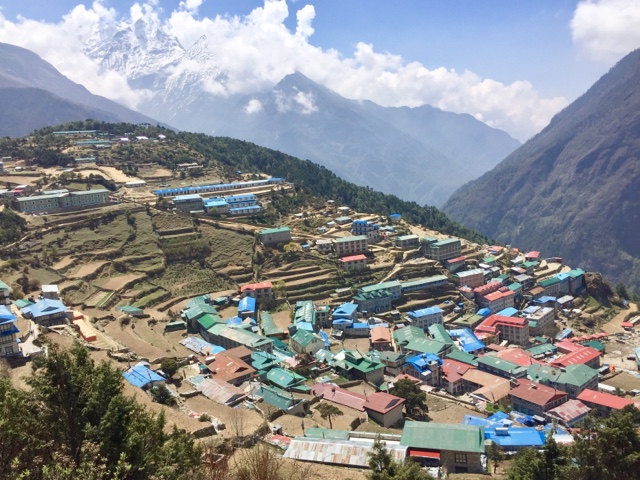Goodbye Namche And Other Stories
Today is our last day at this hub of activity in the foothills of the Himalaya. Wifi will be patchy, accommodations challenging, altitude certainly an issue, temperatures dropping and I will just have to embrace it all as part of the Everest experience! It will be a little unpleasant and uncomfortable but worthwhile I'm sure.
Many of you must wondering what the food is like for the duration of the trek. When you stay at the lodges and teahouses (their version of the Alpine huts) breakfast and dinner are included, lunch you have wherever you are along the way. Generally, to play safe, you eat like a local.
Dinner is dahl baht, which is rice with lentil soup and another stir fried vegetable (potatoes and something like a local pak choi). Breakfast is a variety of eggs and bread. Lunch is fried rice or noodles. Lots of carbs, no meat and lots of side chilies!
I encountered some New Zealanders at a cafe yesterday who were already in trouble from eating meat. You must remember, we are so high up, food has to be transported up the mountain and refrigeration does not exist. I generally order what my guide does or snack on apple pies (apple pies are big here) in the villages (Herman Helmers is a German bakery in Namche).
Speaking about lentils, unfortunately, this only exacerbates high altitude flatulence explosion. I wrote a blog about this before, so look back among the posts and you will find it.
It is well known that an increased level of flatulence accompanies rigorous trekking to higher altitudes. The lower air pressure allows the gases in your intestines to expand necessitating escape! Add lentils to the equation and no one stands a chance. Thankfully, the winds are strong in Everest during the day. Nights may pose more of a problem, since the teahouses have very thin walls. Fortunately, incense and dried yak dung used to burn the cooking fires help alleviate the odour problem. This trek is probably not a good one to do if you are just dating someone and want to go away for a while.
Speaking about malodorous situations, I remember my good friend Evelyn recounting her Everest experience. She said going to the toilets was such a traumatic experience. Not only do you have to be extremely agile and flexible to manouvre with surgical precision around remnants of inconsiderate people, you have to deal with the stench, as well. Her answer to this, since she unprepared, was to twist tissues with toothpaste and shove them up her nostrils! Very ingenious, but I came prepared with Tiger Balm and Vicks. I am so not looking forward to the "comfort" facilities near base camp. I would rather go behind the trees or bushes but there aren't any at that altitude!
People laugh at my not being able to travel light, but I am extremely prepared for any situation. From water purifiers, to an excessive amount of wipes to disinfect anything, medicines, and extra clothing. I do not plan to run into trouble like I did in the Atlas Mountains of Morocco (see past blog). People also say, why not wash your underwear and socks instead of bringing too many? If your water freezes at your bedside table, then the likelihood of frozen, icy newly washed underwear is very high. Porters are trained to carry up to a hundred kilos. They'd be grateful for the same fee and carry your 30 kilos of extra underwear, socks, and sanitising equipment. The Nepalese in the Khumbu valley are desperate for any extra income so employ the extra porter.
Tomorrow we are off to Debouche and sleeping above 4000 metres.







So so proud of you!!! Keep going. You are doing great! Xx
ReplyDelete